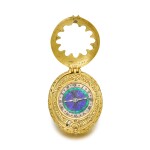Centuries of Time: A Private Collection
Centuries of Time: A Private Collection

German
A rare and early gilt-metal two-train clock watch with stackfreed and enamel dial Circa 1580
Auction Closed
May 14, 02:23 PM GMT
Estimate
12,000 - 18,000 CHF
Lot Details
Description
German
A rare and early gilt-metal two-train clock watch with stackfreed and enamel dial
Circa 1580
• Movement: gilt-brass full plate, verge escapement, plain two-arm foliot with S-shaped cock secured by a screw, hog's bristle regulator, the arm with short scale engraved to backplate, G-shaped stackfreed spring and roller, going and strike barrels with gilt engraved covers, square baluster pillars, governor pinion with brass cylindrical weight, shield-shaped hammer striking shallow bell mounted to inside back, movement secured by two dog screws
• Dial: silver, champlevé Roman numerals with star-form half-hour divisions between, centre with cloisonné enamel radiating panels of dark blue translucent enamel bordered by green enamel forming a gothic rosette, outer gilded border decorated with arabesques, the single hand with tulip form tip and central rosette, aperture to the edge between 6 and 7 o'clock to set striking
• Case: gilt-brass, the back composed of pierced and engraved central panel with arabesques and serpents, outer scrollwork, case sides decorated in relief, lid lacking central gothic rosette, the frame remaining with scalloped border, outer scrollwork, short turned pendant and loose ring
length including pendant 63mm
Sandberg Collection.
Terence Camerer Cuss, The Sandberg Watch Collection, 1998, pp. 32-33.
C. Jeanenne Bell G. G., Collectors' Encyclopedia of Pendant and Pocket Watches, 2004, p. 11.
R. Chadwick, A Voyage Through Time, London: Unicorn, 2020, pp. 12-13.
The Stackfreed was invented in Germany in the second quarter of the 16th century. An attempt to regulate the varying power of the mainspring as it unwound, the device was intended to replace the need for a fusee. Early fusees had considerable depth and therefore required correspondingly deep watch cases to accommodate them. By dispensing with with fusee and replacing their function with the stackfreed, slimmer German watches began to appear. In the present lot, the Stackfreed spring is particularly noteworthy for its unusual G-shaped design, its form allowed it to press with varying force upon the roller mounted indirectly to the barrel's arbor. Also notable is the shallow bell fixed to the inside of the case back which is struck by a shield-form hammer mounted to the movement's backplate.
In common with many other early watches, the grill to the lid that formed the dial's protective cover has been removed - this was most likely carried out soon after the watch was made to allow the easier reading of the dial. From the outline of its edges, the form of the original gothic rosette can be imagined. Few watches from this period are known with cloisonné enamel dial decoration and the design of the enameling would have reflected the rosette design to the lid's centre.
